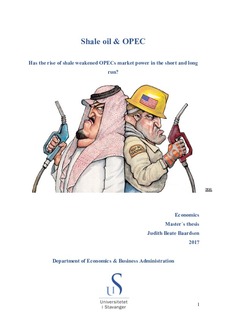| dc.description.abstract | Since 2014, the world have experienced a different world in terms of oil prices. There has been an oversupply in the market as well as lower demand growth than expected. Especially the rise of shale in the US took analysts and experts by surprise and the extra supply from shale was not calculated in forecasts.
As prices plummeted, the world looked to OPEC, which had traditionally taken on the role of being a swing producer. When OPEC had their meeting in November of 2014, the market expected them to cut in production to stabilize the market. Instead, OPEC decided to stay with the same levels and we saw a further decrease in oil prices.
OPEC have been characterized as a cartel in the literature, but through using Alhajii & Huettner`s (2000a) six characteristics of a successful cartel, it seems evident that shale has had its impact on OPECs market power in the global oil market and that the cartel is not as efficient and successful as it might have been in the past. While some of the characteristics of a successful cartel seems to have been missing from the establishment of the organization, others are fulfilled. Some of the characteristics, which make a cartel, has not been impacted by the rise of shale, other have clearly set its mark and have affected OPECs ability to respond and stabilize the market. One direct result of the rise of shale has been changes in OPECs export as well as their percentage of total world consumption.
One of the most important channels OPEC has had in utilizing their market power has been through their spare production levels, which are now at low levels.
As a response to lower oil prices, OPEC has in the past cut production levels, to a point where supply meets demand. This has had some success in the past as non-OPEC producers have traditionally had higher cost levels than OPEC and could not compete at low oil prices. This has changed with the shale revolution. Break-even prices of some shale fields range all the way down at $40, meaning that oil prices above this, they can still make money. As of June 2017, OPEC has not been able to raise the prices significantly and has made a plea to the US to join the production cuts, as it seems they are not able to do so themselves. In my opinion however, it seems as though OPEC is still an important player in the market, but that they have lost some of their market power due to shale. As we saw prices respond shortly after their announcements, it seems that OPEC have power and influence in the short run, but that in the long run, it is difficult to influence more heavy and long run price shocks as there are many other factors influencing the market. | nb_NO |

